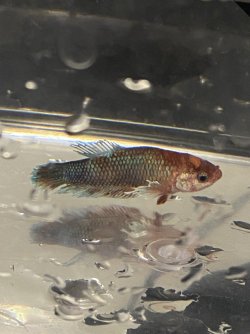Fishiies
New Member
I have a very very peaceful, all female sorority, 4 of the bettas are sisters. i had a fith fish from the same spawn but she died of a weird ailment, inactivity and her fins started disappearing. she also had a weird deformity in her face, almost where it looked sunkin in under her chin, and her gills were starting to flare. WELL two more girls from the same spawn are currently dying from the disease/sickness the first girl passed from, and the third is starting to show early symptoms as well. which means 4/5 of the sisters have died/are showing signs of this same illness. I'm wondering if its genetic, or if someone on here can identify what this is? because it has only affected the sisters. i also have 4 other females and a few other random fish in this tank and none of them are showing any signs of distress or illness.
i attatched a photo of one of them, see how her top fin is starting to almost rot away and only a few spines are poking up?? im so confused bc of all the bettas ive ever owned, i havent seen anything like this.
parameters are 0 ammonia 0 nitrites 5 nitrates. heated to 78°. PH is around 7. i do weekly 30% water changes and test my water very frequently. i have 9 tanks currently and ive never seen anything like this. i feed frozen and live food only
i attatched a photo of one of them, see how her top fin is starting to almost rot away and only a few spines are poking up?? im so confused bc of all the bettas ive ever owned, i havent seen anything like this.
parameters are 0 ammonia 0 nitrites 5 nitrates. heated to 78°. PH is around 7. i do weekly 30% water changes and test my water very frequently. i have 9 tanks currently and ive never seen anything like this. i feed frozen and live food only




 I actually would really love your input on this, as I dont want to spread bad information.
I actually would really love your input on this, as I dont want to spread bad information.